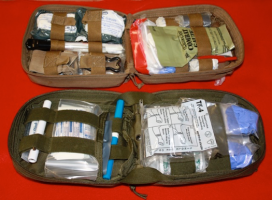 Gun shows are great places to meet kindred spirits and at the last one I went to I met David Dietrich who is co-owner of GetReady! Emergency Planning Center, getemergencyready.com. He was selling a fantastic range of Trauma items (although I admit he got my attention with a small pack on his stall labeled “Vasectomy Kit.”) Anyway, I asked him to come up with something that would really be of use to you guys and he produced a doozy. Check this list out. Thanks David, this is really useful.
Gun shows are great places to meet kindred spirits and at the last one I went to I met David Dietrich who is co-owner of GetReady! Emergency Planning Center, getemergencyready.com. He was selling a fantastic range of Trauma items (although I admit he got my attention with a small pack on his stall labeled “Vasectomy Kit.”) Anyway, I asked him to come up with something that would really be of use to you guys and he produced a doozy. Check this list out. Thanks David, this is really useful.
Most people likely think about equipment for trained specialists in Emergency Medical Services (EMS) when they hear “Trauma Kit.” Other terms used are “Blow-Out Kit,” and “Individual First Aid Kit” (IFAK). However, they would be wrong. Such kits are instead designed to be used by the first responder, whether he is a police officer, infantryman, or just a Good Samaritan.
A Trauma Kit is a far cry from a typical First Aid Kit. While the latter is designed to support minor injuries and medical issues, the former is essential for saving someone’s life in the next ten minutes. That means such kits are focused on major bleeding from gunshots, stabbings, and amputations. In addition, they address breathing obstructions from anaphylaxis or massive tissue damage.
For the purposes of post-disaster preparedness, a Trauma Kit provides coverage where there will likely be no medical services for some time. That means we will be on our own. We ourselves may be not only the first responder, but also the last. So, acquiring and learning to use the components of such a kit is a critical capability. This is one reason why so many military combatants have survived serious wounds in our recent wars.
One axiom is indisputable – all bleeding stops. The question becomes, how it will stop? Do you want to let it stop on its own, after the casualty has bled out, or do you want to play an active role, stopping the bleeding yourself in sufficient time for the casualty to become an asset once again? The Trauma Kit provides a means to that end, through various included devices.
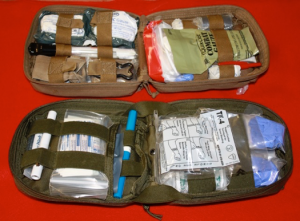
So, what does a Trauma Kit look like? First of all, it is relatively small, easily carried on a belt, armor plate, or in a backpack. Secondly, it does not usually contain the items we expect to see in First Aid Kits. Rather, they include tourniquets, pressure bandages, blood clotting agent, occlusive dressing, tension pneumothorax needle, and nasopharyngeal airway. There may be a few other odds and ends as well, but those are the basics.
Let’s take a look at components of a trauma kit, to better understand why they are used:

Tourniquet. There are many designs and brand available, from simple rubber tubing to complex windlass or ratcheting designs. But, they all have one purpose – to constrict or eliminate blood flow to the bleeding extremity. While these used to be a tool of last resort, military experience has proven their worth in saving lives as the tool of first choice. If properly applied and combined with other devices, they can be safely removed later.
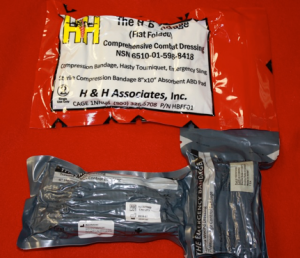
Compression (Pressure) Bandage. There are several commercial brands out there, typically based on the original Israeli Bandage. As the tried and true method for staunching blood flow is pressure and elevation, their purpose is to maintain pressure at the injury site, as well as provide a clotting medium. This is accomplished through an integrated dressing and pressure device. The hands are then left free to perform other functions. Here are some examples of commercially available Pressure Bandages:
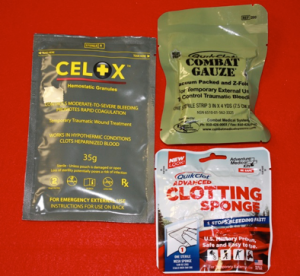
Hemostatic (Clotting) Agent. There are mainly two commercial brands out there, found in three forms. These are QuikClot and Celox, using sponges, gauze wraps, or poured granules. The key component is either a clay mineral (kaolin), used in QuikClot, or a crustacean derivative (chitosan), used in Celox. Both types interact with blood plasma to rapidly form clots. They work independently of blood platelets or thinning drugs.
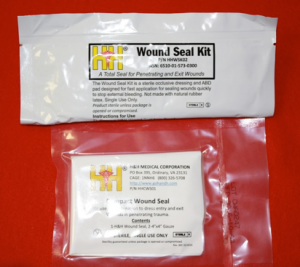
Occlusive Dressing (aka Chest Seal). Several brands are used by the military and other agencies. They are designed to block inhalation through the thoracic cavity, rather than normally, into the lungs. If such a condition, known as a “sucking chest wound,” is allowed to continue, the lung on that side will likely collapse, putting pressure on the aorta and heart, resulting in painful breathing and associated circulatory problems.
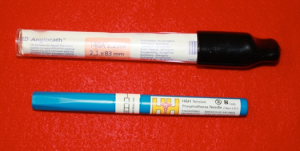
Tension Pneumothorax Needle (TPN). Several brands are used by the military and other agencies. They are designed to release air and/or fluid pressure in the external thoracic cavity that may lead to the same conditions described under Occlusive Dressing above. So, this device is for closed, versus open chest wounds. The TPN is probably the most difficult of all the Trauma Kit devices to apply, and should by studied and practiced.
Naso-Pharyngeal Airway (NPA)
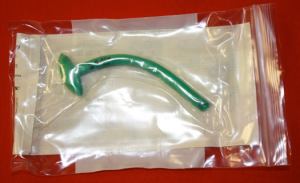
Numerous brands are used by the military and other agencies. They are used to maintain breathing in the event of an airway blockage due to anaphylaxis or tissue damage. They are basically comprised of a stiffened rubber tube, beveled on one end and enlarged into a bell shape on the other. Assisted by accompanying water-based lubricant, they are fully inserted into a nostril up to the bell.
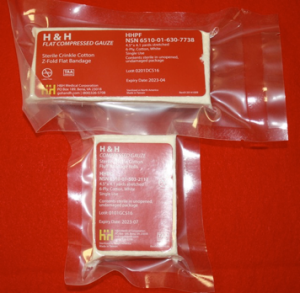 Compressed Gauze. Numerous brands are used by the military and other agencies. They are used primarily to absorb and aid in the clotting of blood. Almost always comprised of cotton, they are the most versatile Trauma Kit component. And it cannot be overstated that you can never have enough gauze. Additional uses include absorbing other bodily fluids, covering burns and lacerations, wrapping dressings, and securing splints.
Compressed Gauze. Numerous brands are used by the military and other agencies. They are used primarily to absorb and aid in the clotting of blood. Almost always comprised of cotton, they are the most versatile Trauma Kit component. And it cannot be overstated that you can never have enough gauze. Additional uses include absorbing other bodily fluids, covering burns and lacerations, wrapping dressings, and securing splints.
Trauma Shears
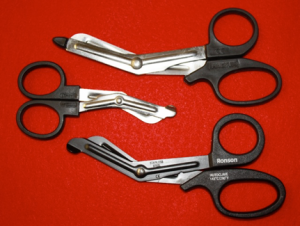
Numerous brands are used by the military and other agencies. They are used primarily to cut away clothing and other accessories (eg bra underwire) to quickly access the point of injury. Their unique design provides a safe and easy method to cut through almost anything, including coins! The major take-away regarding arterial bleeding is that saving clothing comes in a distant second to saving a life.

Pictured are rolls from eGear and H&H Medical. Also found among survival gear, they range in price from approximately $1 to $4 each.
Medical (Duct) Tape. This ubiquitous resource really comes into its own in a medical kit. Not only can it be used to secure bandages and dressings, but it also has applications for foot care (eg prevention and treatment of blisters), wrapping splints, making snow goggles, and repairing medical gear and other items. Mini rolls, primarily for storage purposes, are the best configuration. Don’t leave home without them!
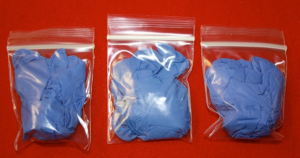
Medical Gloves. These are included in Trauma Kits primarily to protect the responder, not the patient. Bodily fluids can carry many dangerous diseases, and having additional barriers during treatment may keep the responder from becoming a casualty. In addition, they may preclude the need for further cleansing following treatment. Simple glove removal and disposal may be sufficient action under tactical conditions.
Marking Pen
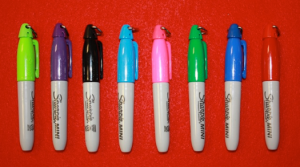
This is important not only for recording information on a Casualty Card, but also for marking other information, such as the date and time of a tourniquet application. Such marking can be on the device itself, or even on the forehead of the patient. There are other uses for such pens, such as taking notes on environmental conditions, and descriptions of agents (eg animals, plants, suspects) involved.
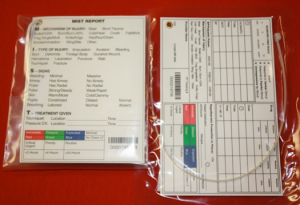
Casualty Response Documentation Tool (CRDT).
This is an event recording card, containing information describing patient and injury, treatment (including drugs) administered, mental state, circulation, respiration, mechanisms of injury (MOIs), medical conditions, and overall patient medical status, from routine to critical. It’s always good to keep track of what’s happening in such cases, for reference prior to future treatment.
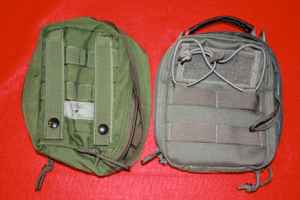
Pictured are medical pouches from Eagle Industries and Maxpedition. Another common brand is Rothco. They range in price from approximately $15 to $45 each.
Pouch. Typical military kit dimensions are 8 inches long by 6 inches wide by four inches deep when full. It uses the Pouch Attachment Ladder System (PALS) to fasten to Modular Lightweight Load-Carrying Equipment (MOLLE) configured backpacks. Made of rugged Cordura nylon, this Pouch can be used under adverse environmental and tactical conditions. It should be readily accessible for immediate use.
Other Components. A number of other items may be included in a Trauma Kit for various reasons. For example, if the owner would like to access the kit for minor injuries, and not dip into important trauma components, then adhesive bandages may be included. In addition, medications (eg aspirin) should be considered. Sterile wipes and water for cleaning wounds, flashlight for nighttime, and CPR shield round out the list.
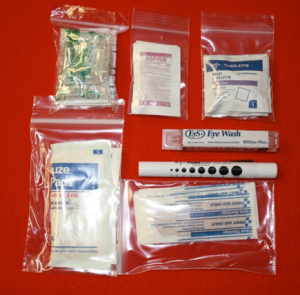
Pictured are a CPR Shield, regular strength Aspirin, Moist Towelettes, Sterile Water, Penlight, Adhesive Bandages, and Gauze Pads. They range in price from approximately $1 to $5 each.
_________________________________________________________________
David Dietrich is co-owner of GetReady! Emergency Planning Center, getemergencyready.com. He has been preparing for uncertainty since he was a youth, recognizing that backpacking is about smaller, lighter, and multi-capability. His experiences in the Boy Scouts and military have given him an appreciation for the real meaning of the Scout Motto – “Be Prepared.” Today, David runs a disaster preparedness business that is focused on the creed – helping you help yourself. It is about delivering resources, training, education, and consulting in preparation for a failure of civility. Prepared people are survivors.
